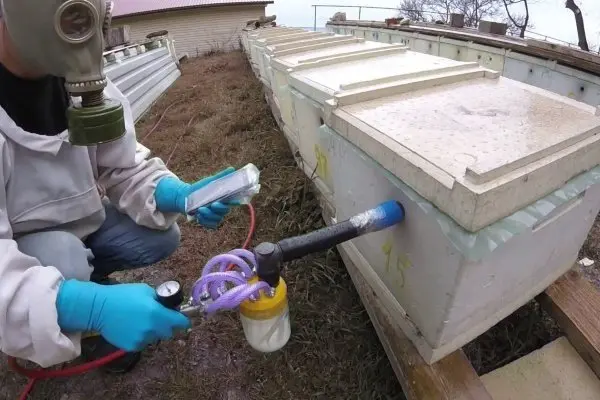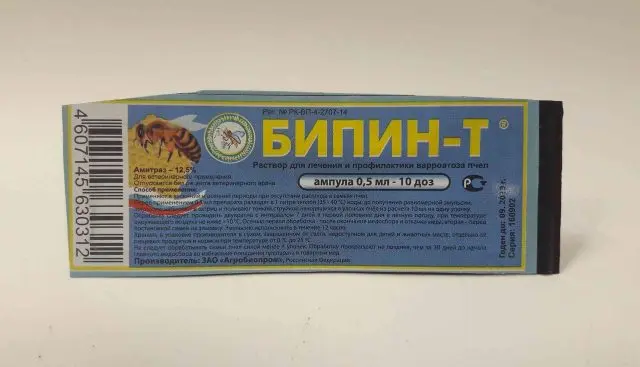Contents
Amitraz is a medicinal substance that is part of preparations for the treatment of bee diseases. They are used for preventive purposes and to eliminate tick-borne infections in the hive. Acquaintance with these preparations should be carried out by every beekeeper who cares about the health of his wards.
The use of amitraz in beekeeping
Amitraz is an organic compound of artificial origin. It is also called acaricide. The substance belongs to the category of triazopentadiene compounds. Medicines based on amitraz are effectively used to combat acarapidosis and varroatosis in bees. In some cases, they are used to prevent these diseases. Due to the moderate degree of toxicity in the use of amitraz, it is extremely important to observe safety precautions.
Amitraz has a targeted effect on ticks, which are sources of varroatosis and acarapidosis. Preparations based on it are produced in the form of a solution. With its help, the bee dwelling is processed during the period of increased likelihood of infection.
Due to increased toxicity, treatment of the hive with 10 µg of amitraz leads to the death of about half of the bees. Therefore, to achieve a therapeutic effect, minimal dosages are used.

When infected with acarapidosis, mites concentrate in the trachea of bees. It is not always possible to diagnose the disease in a timely manner, since the first signs of the disease become noticeable only a few years after infection. Treatment with amitraz leads to the death of mites. But beekeepers may get the impression that the drug has harmed the bees as well. After treatment, single corpses of insects can be found at the bottom of the hive. The cause of their death is blockage of the trachea by ticks. This fact has no direct relationship with treatment.
Amitraz-based preparations
There are several drugs containing amitraz, which are actively used by beekeepers to treat tick-borne diseases. They differ in additional components and the concentration of the active substance. The most effective drugs include:
- “Polisan”;
- “Apivarol”;
- “Beep”;
- “Apitak”;
- “THEDA”;
- “Tactics”;
- “Varropol”;
- “Amipol-T”.
Polisan
“Polysan” is produced in the form of special strips, which, when burned, form smoke with a sharp acaricidal effect. It actively affects adult mites of varroatosis and acarapidosis. It is customary to use the drug in the spring after the flyby of the bees and in the fall after the harvest. This prevents the medicinal substance from getting into the honey.
The bee hive is treated with Polisan at a temperature above 10°C. It is advisable to process in the early morning or evening, after the bees return to their homes. One strip of the drug is designed for 10 frames with honeycombs. The packaging should be opened immediately before being placed in the hive. One hour after placing the strip, it is necessary to check the completeness of combustion. If it is completely dead, the notches are opened to ventilate the bee house.
Apivarol
“Apivarol” is available for purchase in tablet form. The concentration of the active substance is 12,5%. The country of manufacture of the drug is Poland. For this reason, the cost of “Apivarol” is higher than the price of other drugs with amitraz. Most often, the drug is used to treat varroatosis in bees.
The tablet is set on fire, and after the appearance of the flame, it is blown out. This causes the tablet to continue to smolder, emitting puffs of smoke. 1 tablet is enough for a course of treatment. It is desirable to use a metal substrate to support the ember tablet. It is placed in the middle of the nest through the notch. It is important to ensure that the strip does not touch the tree. Processing of bees is carried out for 20 minutes. In some cases, it is repeated, but no later than 5 days later.
Beep

“Bipin” is a yellowish liquid with a repulsive odor. On sale it is found in packages with ampoules of 0,5 ml and 1 ml. Before use, the drug is diluted with water at the rate of 1 ml per 2 liters of water. The water temperature should not exceed 40 °C. Immediately after dilution, the medicine must be used. Otherwise, it will deteriorate.
To process bees, the solution is poured into a plastic bottle, in the lid of which holes are made. You can also use a medical syringe or a smoke gun. If necessary, it is made independently using improvised materials. Processing must be carried out in a protective suit. It is equally important to protect the respiratory organs from toxic smoke.
Apitak
Apitak is produced in ampoules with a solution at a concentration of 12,5%. The volume of 1 ml and 0,5 ml is available for purchase. 1 package contains 2 ampoules with a solution. In addition to the main component, the composition of the drug includes neonol and thyme oil.
“Apitak” for bees is used mainly for varroatosis. The desired effect is achieved due to a pronounced acaricidal action. The active substance blocks the transmission of nerve impulses in ticks, which leads to their death. Thyme oil enhances the effect of the main component. That is why the drug is in great demand.
With the help of “Apitak” bees are treated in the fall. The most favorable conditions for the procedure are at temperatures from 0°C to 7°C. In the middle lane, processing is carried out in mid-October.
Before carrying out therapeutic measures, 0,5 ml of the substance is diluted in 1 liter of warm water. 10 ml of the resulting emulsion is calculated per street. Re-treatment of the bee dwelling is carried out in a week. In the smoke gun “Apitak” is laid in the case when you need to get rid of not only varroatosis, but also from acarapidosis. Spreading the drug by spraying is considered less effective.
TED

In order to fumigate the bee dweller, the preparation “TEDA” for bees is often used. Instructions for use dictate a three-time treatment of the hive with varroatosis and six times with acarapidosis. Amitraz-based drug is produced in the form of a cord, 7 cm long. The package contains 10 pieces.
The preparation “TEDA” for bees is used in the autumn period. The main condition for processing is a temperature not lower than 10 ° C. 1 cord is enough for the treatment of one bee family. At one end, it is set on fire and placed on plywood. In a smoldering state, the cord should lie in the hive until it burns out completely. For the period of processing, the entrance must be closed.
Tactician
“Taktik” saves the hive from varroatosis due to the acaricidal action of amitraz. When used correctly, amitraz does not adversely affect bees and does not reduce the quality of honey. The drug is sold in the form of a solution with a high concentration of the active substance. 1 ml of solution is enough for 20 treatments. Before use, “Tactics” is diluted with water in a ratio of 1: 2.
The process of diluting the solution is carried out immediately before processing. Amitraz is not intended for long-term storage. The process of spreading “Tactics” is carried out using a smoke gun.
Varropolis
The release form of “Varropol” differs from other variations containing amitraz. The drug is a strip. They are placed in the hive for a long time. You don’t need to burn the strips. The bees will spread the amitraz around their home on their own with the help of hairs that cover their body. For 6 frames you will need 1 strip of Varropol.
When unfolding the strips with amitraz, care must be taken. It is advisable to put on rubber gloves first. After treatment, do not touch your face. This can lead to toxic substances entering the eyes.
Amipol-t
“Amipol-T” is produced in the format of smoldering strips. Amitraz is the main active ingredient. 10 strips are enough for 2 frames. If the bee family is small, then one strip is enough. It is located in the middle of the nest. The duration of the strips in the hive varies from 3 to 30 days. It depends on the degree of neglect of the disease and the amount of printed brood.
The location of the stripes and their number depend on how weak the family is. 2 pieces are placed in a strong family – between 3 and 4 combs and between 7 and 8. In a weak family, one strip will be enough.
Shelf life and storage conditions
Preparations containing amitraz on average retain their properties for 2 years from the date of manufacture. The optimum storage temperature ranges from 0°C to 25°C. It is advisable to keep medicines in a dark place, away from children. Diluted medicine in emulsion format can be stored for only a few hours. It is advisable to process the bees immediately after preparation, since amitraz deteriorates quickly enough. With proper use and storage, the likelihood of developing negative effects is extremely small.
Conclusion
Amitraz has a high degree of effectiveness. The result of successful disposal of ticks is 98%. The disadvantages of the substance include high toxicity. To avoid unforeseen complications, safety precautions must be observed.









